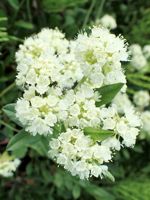Mon-Fri 9am - 5pm Mountain time
Chives vs Sulphur-Flower Buckwheat
Allium schoenoprasum
Eriogonum umbellatum
NOT AVAILABLE THIS SEASON - MIGHT RETURN
CUSTOM GROW
Chives are small bulbous perennials commonly used as herbs in cooking for a mild onion like flavour. Chives also add ornamental benefits to your yard with their tubular grass-like leaves and clusters of pale purple flowers. The flower heads can also be used as a garnish or in oils.
It is best to harvest Chives from the base to maintain the attractive clumps. If the flowers are not dead-headed, it will self-seed. Planting our overwintered chives will give you a head start in your vegetable garden.
Sulphur-Flower Buckwheat is a native perennial wildflower known for its dense clusters of cream to yellow flowers. The long-lasting blooms persist from late spring into summer, providing an extended nectar source for a variety of pollinators. The flower buds are often red-tinted before opening. As the blooms age, they shift to orange or red, adding seasonal interest and making them well-suited to dried flower arrangements. Its seeds are also eaten by birds, adding to its ecological value.
Depending on climate and conditions, Sulphur-Flower Buckwheat may be evergreen to semi-evergreen, or its foliage may turn red during fall. Its deep roots and spreading growth stabilize rocky or sandy soils, making it useful for erosion control. Exceptionally hardy once established, it requires little care and thrives in challenging environments, making it an excellent choice for pollinator gardens, naturalization, and ecological restoration projects.

